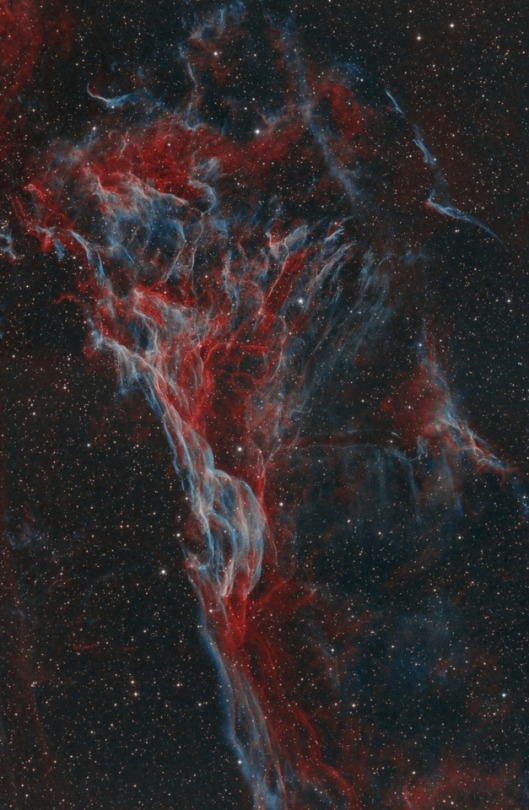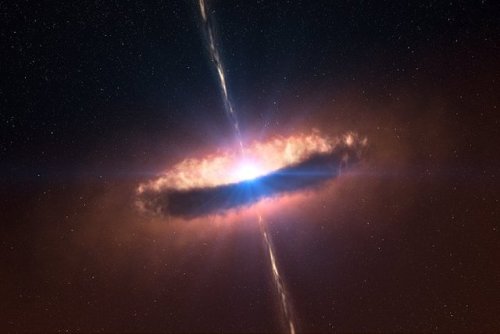Cosmicinsightz - Within The Cosmos

More Posts from Cosmicinsightz and Others


Wispy remains of a supernova explosion hide a possible ‘survivor.’ Of all the varieties of exploding stars, the ones called Type Ia are perhaps the most intriguing. Their predictable brightness lets astronomers measure the expansion of the universe, which led to the discovery of dark energy. Yet the cause of these supernovae remains a mystery. Do they happen when two white dwarf stars collide? Or does a single white dwarf gorge on gases stolen from a companion star until bursting? If the second theory is true, the normal star should survive. Astronomers used the Hubble Space Telescope to search the gauzy remains of a Type Ia supernova in a neighboring galaxy called the Large Magellanic Cloud. They found a sun-like star that showed signs of being associated with the supernova. Further investigations will be needed to learn if this star is truly the culprit behind a white dwarf’s fiery demise.
This supernova remnant is located 160,000 light-years from Earth. The actual supernova remnant is the irregular shaped dust cloud, at the upper center of the image. The gas in the lower half of the image and the dense concentration of stars in the lower left are the outskirts of a star cluster.
Image credit: NASA, ESA and H.-Y. Chu (Academia Sinica, Taipei)

Remnants from a star that exploded thousands of years ago created a celestial abstract portrait, as captured in this NASA Hubble Space Telescope image of the Pencil Nebula.
Credit: NASA and The Hubble Heritage Team (STScI/AURA)

Arp 240, Galaxy Bridge




What is a protostar?
The formation of stars begins with the collapse and fragmentation of molecular clouds into very dense clumps. These clumps initially contain ~0.01 solar masses of material, but increase in mass as surrounding material is accumulated through accretion. The temperature of the material also increases while the area over which it is spread decreases as gravitational contraction continues, forming a more stellar-like object in the process. During this time, and up until hydrogen burning begins and it joins the main sequence, the object is known as a protostar.
This stage of stellar evolution may last for between 100,000 and 10 million years depending on the size of the star being formed. If the final result is a protostar with more than 0.08 solar masses, it will go on to begin hydrogen burning and will join the main sequence as a normal star. For protostars with masses less than this, temperatures are not sufficient for hydrogen burning to begin and they become brown dwarf stars.
Protostars are enshrouded in gas and dust and are not detectable at visible wavelengths. To study this very early stage of stellar evolution, astronomers must use infrared or microwave wavelengths.
Protostars are also known as Young Stellar Objects (YSOs).

Seven Worlds for TRAPPIST 1 : Seven worlds orbit the ultracool dwarf star TRAPPIST-1, a mere 40 light-years away. In May 2016 astronomers using the Transiting Planets and Planetesimals Small Telescope announced the discovery of three planets in the TRAPPIST-1 system. Just announced, additional confirmations and discoveries by the Spitzer Space Telescope and supporting ESO ground-based telescopes have increased the number of known planets to seven. The TRAPPIST-1 planets are likely all rocky and similar in size to Earth, the largest treasure trove of terrestrial planets ever detected around a single star. Because they orbit very close to their faint, tiny star they could also have regions where surface temperatures allow for the presence of liquid water, a key ingredient for life. Their tantalizing proximity to Earth makes them prime candidates for future telescopic explorations of the atmospheres of potentially habitable planets. All seven worlds appear in this artists illustration, an imagined view from a fictionally powerful telescope near planet Earth. Planet sizes and relative positions are drawn to scale for the Spitzer observations. The systems inner planets are transiting their dim, red, nearly Jupiter-sized parent star. via NASA
js

Western Veil



-
 partywithyabi liked this · 1 year ago
partywithyabi liked this · 1 year ago -
 pieface55 liked this · 1 year ago
pieface55 liked this · 1 year ago -
 ahmedchamp1 reblogged this · 1 year ago
ahmedchamp1 reblogged this · 1 year ago -
 jayne-doe liked this · 1 year ago
jayne-doe liked this · 1 year ago -
 theweathermellon liked this · 1 year ago
theweathermellon liked this · 1 year ago -
 doggosupreme reblogged this · 1 year ago
doggosupreme reblogged this · 1 year ago -
 stormkitty97 reblogged this · 1 year ago
stormkitty97 reblogged this · 1 year ago -
 ahmedchamp1 liked this · 1 year ago
ahmedchamp1 liked this · 1 year ago -
 graham65 liked this · 1 year ago
graham65 liked this · 1 year ago -
 404er-or-blog liked this · 1 year ago
404er-or-blog liked this · 1 year ago -
 distresseddove liked this · 1 year ago
distresseddove liked this · 1 year ago -
 dew-ontherocks liked this · 1 year ago
dew-ontherocks liked this · 1 year ago -
 beautiful-w1tches liked this · 1 year ago
beautiful-w1tches liked this · 1 year ago -
 stranger8 liked this · 1 year ago
stranger8 liked this · 1 year ago -
 dr-grimreaper-blog liked this · 1 year ago
dr-grimreaper-blog liked this · 1 year ago -
 naugesofdream-blog liked this · 1 year ago
naugesofdream-blog liked this · 1 year ago -
 holygodyourebronze reblogged this · 1 year ago
holygodyourebronze reblogged this · 1 year ago -
 call-me-a-s1nner reblogged this · 1 year ago
call-me-a-s1nner reblogged this · 1 year ago -
 missmatchedselection liked this · 1 year ago
missmatchedselection liked this · 1 year ago -
 nergalluna liked this · 1 year ago
nergalluna liked this · 1 year ago -
 morphthemoment reblogged this · 1 year ago
morphthemoment reblogged this · 1 year ago -
 stellarlovely reblogged this · 1 year ago
stellarlovely reblogged this · 1 year ago -
 myglorydayswon liked this · 4 years ago
myglorydayswon liked this · 4 years ago -
 weeping-mistytree reblogged this · 4 years ago
weeping-mistytree reblogged this · 4 years ago -
 weeping-mistytree liked this · 4 years ago
weeping-mistytree liked this · 4 years ago -
 perfectframes reblogged this · 4 years ago
perfectframes reblogged this · 4 years ago -
 lavender--cake liked this · 5 years ago
lavender--cake liked this · 5 years ago -
 ladykarloff liked this · 5 years ago
ladykarloff liked this · 5 years ago -
 realghostyeah liked this · 6 years ago
realghostyeah liked this · 6 years ago -
 engowl liked this · 6 years ago
engowl liked this · 6 years ago -
 scootis-the-scoot liked this · 6 years ago
scootis-the-scoot liked this · 6 years ago -
 thedoctorsawkwardhufflepuff liked this · 6 years ago
thedoctorsawkwardhufflepuff liked this · 6 years ago -
 panthera--tigris--altaica liked this · 6 years ago
panthera--tigris--altaica liked this · 6 years ago -
 wojack55 liked this · 6 years ago
wojack55 liked this · 6 years ago -
 ajc18615425 liked this · 6 years ago
ajc18615425 liked this · 6 years ago -
 shott-pilgrim reblogged this · 6 years ago
shott-pilgrim reblogged this · 6 years ago -
 jester-toon-rabbit liked this · 6 years ago
jester-toon-rabbit liked this · 6 years ago -
 ramblingsofastarrider reblogged this · 6 years ago
ramblingsofastarrider reblogged this · 6 years ago -
 algo-magico-blog liked this · 6 years ago
algo-magico-blog liked this · 6 years ago -
 dreamyangtianqi liked this · 6 years ago
dreamyangtianqi liked this · 6 years ago
a collection of all cosmic ephemeralities and phenomenons. a blog dedicated to exploring the vastness of the universe
66 posts